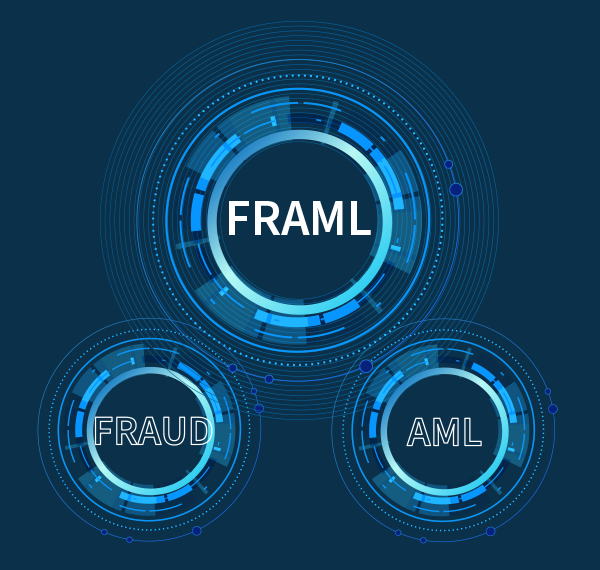
FRAML: The Rising Necessity in Combatting Financial Crime
Merging Fraud Prevention and Anti-Money Laundering
FRAML is not a new phenomenon. The idea that fraud and anti-money laundering (AML) monitoring processes can be consolidated for greater efficiency and effectiveness has been around for the best part of two decades. So why is there now renewed interest in FRAML from a wide set of financial and corporate institutions?
To begin with, financial criminals are becoming more sophisticated, whether it’s those defrauding individuals or institutions, or those further downstream who legitimise the ill-gotten gains. And this is making the detection and prevention of fraud and other financial crimes ever more complex with the need for highly customised and focused approaches for each crime.
But there is also a realisation among organisations that to effectively detect and prevent fraud and money laundering, they first must fully understand it. When fraud happens, in most cases, there is by definition money laundering, as criminals use mule accounts, layering techniques and complex transaction patterns to move and disguise the stolen funds. This interconnected nature of fraud and money laundering means that tackling one without addressing the other leaves critical gaps in risk detection and prevention.

This growing awareness has encouraged the development of three types of ‘FRAML’:
Operational FRAML
The most conventional type, which has been around the longest. Institutions, typically smaller banks, combine their functions to oversee fraud and AML under one roof.
Under this model, firms benefit largely from the increased efficiency gained by deploying and using two systems together.
Analytical FRAML
An emerging approach, more common in larger institutions like big banks. In this model, fraud and AML functions remain separate, but analytics and risk signals for both are integrated into their respective systems. Examples of this model in action include:
- Supplementing AML alerts with behavioural and location analytics to identify unusual activity that is likely to be the facilitation of money laundering.
- Enriching fraud alerts with contextualised AML or Know Your Customer (KYC) data. This use case has become more prevalent because a combined view of fraud and AML can have a profound impact on a firm’s ability to detect mule accounts, which have been on the rise in recent years.
A combination of fraud and AML in a single solution
Even when both business functions are separate. The main benefit of this approach, which is also gaining traction, is that when there is a spike in fraud activity, AML analysts can be more easily deployed to fraud roles – and vice versa.
This approach even has its own term – ‘FRoML’ – because technically it is an application of ‘fraud or’, rather than strictly ‘fraud and AML.’
Crucially, while FRAML is often used to describe the applications listed above, true FRAML goes beyond simply combining fraud and AML functionality. Ideally, a broad range of risk signals should be consolidated into a unified system.
Chartis Research, an independent research firm that specialises in risk technology across financial crime, financial risk, governance, risk management and compliance (GRC) and trading, has identified two noteworthy use cases of FRAML in action.
There has been a notable rise in the ‘FRoML’ approach, notably among FinTechs, who are putting the necessary building blocks in place to enable a more flexible operating model.
A mid-tier payments startup with a risk team of approximately 60 staff across fraud and AML implemented a FRoML approach by integrating fraud and AML detection into a single platform with a universal interface and case management capabilities. The firm described this shift as a “game changer”, allowing it to seamlessly reassign analysts between fraud and transaction monitoring alerts with minimal disruption.
Benefits:
Efficiency gains are estimated at a 20% improvement in productivity, with projections suggesting this could increase to as much as 40% over the next 12 months. These stem from faster alert resolution, reduced analyst downtime during periods of low alert volume and more efficient investigations.
The company also experienced a coincidental upside: faster onboarding due to fewer bottlenecks, which led to a reduction in drop-off rates and a higher number of new customers. Furthermore, while the firm initially planned a six-month window to train and upskill analysts to operate across both domains, it achieved this in just over two months.
A more niche but impactful example is the use of FRAML analytics. This approach is gaining traction across financial institutions of all sizes, with uptake among larger firms.
A prominent Tier 1 bank in North America implemented a FRAML analytics approach over a year ago. The model feeds information from multiple sources - including data and risk signals from its fraud-detection, KYC, documentation, sanctions and transaction monitoring functions - into a single analytical interface that can be accessed by its fraud and wider FinCrime teams.
Benefits:
The bank increased its detection of mules by more than 30% in the first year of implementation.
Time to make a start?
New phenomenon or not, FRAML is here to stay. At some point or another, many firms may have considered, and rejected, employing a consolidated approach. But with the growing availability of FRAML and orchestration solutions, it’s time to think again.
A common criticism of traditional FRAML approaches is their lack of flexibility—but this is changing. Organisations looking to implement a combined fraud and AML strategy must ensure their integrated system is flexible enough to meet immediate needs.
However, it’s equally important to recognise that, in the medium and long term, the requirements for scalability and flexibility will evolve—often beyond recognition. Institutions should therefore begin laying the groundwork today to enable successful future deployments. And the first step is to start assessing and defining their own business cases, and the gaps they will need to address.
